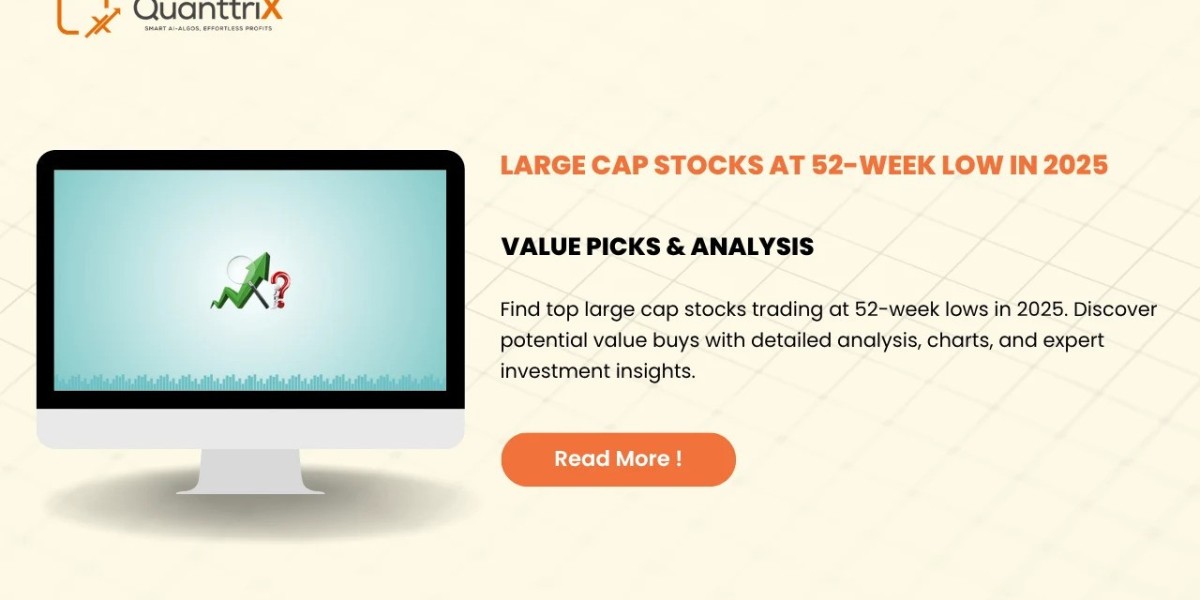Large Cap Stocks at 52-Week Low: Hidden Gems or Red Flags?
Introduction
What if I told you some of the most trusted giants in the stock market are now available at discounted prices? That’s right—many large cap stocks are trading near their 52-week lows, and for investors with a keen eye, this might just be the golden opportunity they’ve been waiting for.
But here’s the catch—not every low price is a good deal. Some stocks are cheap for a reason. So, how do you tell the difference between a hidden gem and a falling knife? That’s what this article is all about.
We’ll walk through the current market scenario, explain what a 52-week low really means, and help you explore good large cap stocks that might be worth your attention. Plus, we’ll dive into how automated trading software is changing the game for retail and professional investors alike.
Explore 52 week low large cap stocks, good large cap stocks, and how automated trading software helps spot undervalued opportunities.
What Are Large Cap Stocks?
Large cap stocks are companies with a market capitalization typically over ₹20,000 crores (or $10 billion internationally). Think of Reliance Industries, Infosys, or Tata Consultancy Services. These are the giants—stable, well-established, and often leaders in their sectors.
They’re like the elephants of the market—slow to fall, but when they do, it catches everyone’s attention.
Understanding the 52-Week Low
The 52-week low is the lowest price a stock has traded at over the past year. It's a psychological and technical benchmark. Investors often look at it to gauge whether a stock is undervalued or if something’s seriously wrong.
But here’s an analogy: a stock hitting its 52-week low is like a luxury car going on sale. You’re tempted, but you still need to check under the hood.
Why Do Large Cap Stocks Hit 52-Week Lows?
Even the best companies can fall out of favor temporarily due to:
Sector downturns (e.g., IT or banking corrections)
Global events (e.g., inflation, war, oil prices)
Internal company issues (earnings miss, management changes)
Regulatory pressures (government policies or taxes)
It’s important not to panic but to investigate. A dip might be temporary—or a red flag.
Opportunity or Trap: Should You Buy at Lows?
Buying low sounds like smart investing. But blindly buying at 52-week lows is like catching a falling knife. You need a solid reason to believe the stock will recover.
Ask yourself:
Is the business model still strong?
Are the issues temporary?
Are valuations attractive?
If the answers are yes, you might just be looking at a hidden treasure.
Signs of Good Large Cap Stocks at 52-Week Low
Look for these green flags:
Consistent revenue and profit growth
Strong balance sheet with low debt
Industry leader or competitive edge
Resilient during economic slowdowns
Positive management commentary
These signs suggest that the drop might be market-driven, not fundamental weakness.
Top 10 52-Week Low Large Cap Stocks (2025 Snapshot)
Here are some notable names (as of July 2025):
Stock | Sector | % Down from 52W High |
Infosys | IT | -28% |
HDFC Bank | Banking | -24% |
Hindustan Unilever | FMCG | -21% |
Wipro | IT | -35% |
SBI Life | Insurance | -22% |
Tech Mahindra | IT | -30% |
ICICI Lombard | Insurance | -19% |
Tata Consumer | FMCG | -18% |
Dr. Reddy’s Labs | Pharma | -20% |
Asian Paints | Chemicals | -17% |
Always cross-check with fundamentals before jumping in.
Sector-wise Breakdown: Where Are the Lows?
Not all sectors are equal. Here's where the most 52-week lows are found right now:
IT Sector: Hit by global tech slowdown and recession fears
FMCG: Valuation correction post-COVID surge
Banking: Due to rising NPAs and interest rate hikes
Pharma: Regulatory headwinds and pricing pressures
Understanding sector-wide trends can help you decide whether the problem is macro or company-specific.
How to Analyze a Stock Hitting 52-Week Low
Use this quick checklist:
P/E Ratio: Is it historically low?
Debt-to-Equity Ratio: Is it manageable?
Earnings Reports: Any recent negative surprises?
Management Guidance: Optimistic or cautious?
Dividend History: Still paying consistently?
Remember: emotion should never replace evaluation.
Role of Fundamentals and Technicals
Think of fundamentals as your heart and technicals as your brain. You need both to make smart decisions.
Fundamentals = earnings, profits, balance sheets
Technicals = support/resistance, volume, RSI
When both align at a 52-week low, it could be a strong buy signal.
How Automated Trading Software Identifies Opportunities
This is where automated trading software comes in. These platforms scan thousands of stocks and alert you to:
52-week lows with improving volume
Oversold signals on technical indicators
Unusual institutional buying
Price patterns or reversals
Some of the best automated trading software in India include:
Quanttrix
Upstox Algo Lab
AlgoTest
Zerodha Streak
They help reduce emotional decision-making and bring speed, discipline, and accuracy.
Risks of Chasing 52-Week Lows
Every opportunity comes with risk. Buying at a 52-week low means:
You might be early (it could fall more)
The problem may be structural, not temporary
Your capital could be stuck longer than expected
Always use stop-losses or hedging strategies to protect downside risk.
Long-Term Investment vs. Short-Term Trade
Are you a long-term investor or a swing trader?
Investors look at business fundamentals and future prospects.
Traders rely on chart patterns, volume, and short-term trends.
Knowing your style helps you decide when and how to buy a stock at a low.
Institutional Buying: What Big Players Are Doing
Follow the smart money.
If mutual funds or FIIs are increasing their stake even as prices fall, it’s a strong vote of confidence.
You can track this via:
Quarterly Shareholding Patterns
Bulk/Block Deal Announcements
NSE/BSE Disclosures
Let their conviction guide yours.
Tools and Platforms for Retail Investors
Here are tools to track 52-week low large cap stocks:
Moneycontrol Screener
Screener.in
TradingView (for charts and alerts)
Tickertape (for valuation insights)
Trendlyne (for FIIs/DIIs data)
Some even offer ready-made watchlists of 52-week low stocks filtered by market cap and sector.
Final Thoughts: Building a Balanced Strategy
Buying stocks at a 52-week low can be a profitable strategy, but only when done right.
Balance is key:
Use automated trading software to spot opportunities.
Analyze fundamentals and sector outlooks.
Be patient and diversify.
Remember, smart investing isn’t about timing the bottom—it’s about making informed decisions based on facts, not fear.
Conclusion
Large cap stocks trading at 52-week lows can feel like fire-sale opportunities. But the real question is—are they good large cap stocks temporarily out of favor, or long-term value traps?
Armed with the right analysis, tools, and a level head, you can identify potential winners and build a stronger, smarter portfolio.
And thanks to modern automated trading software, even retail investors now have the power of algorithms and data science at their fingertips.
Now’s the time to sharpen your strategy and let logic, not fear, lead your trades.
FAQs
1. Are all 52-week low large cap stocks good to buy?
Not necessarily. Some may be undervalued opportunities, while others might be falling for fundamental reasons. Analyze before investing.
2. How can I find good large cap stocks near their 52-week lows?
Use stock screeners like Screener.in, Moneycontrol, or automated platforms that filter based on valuation, earnings, and technical patterns.
3. What role does automated trading software play in spotting these stocks?
It scans thousands of data points to highlight potential buy signals like support levels, volume spikes, or RSI indicators.
4. Is it better to buy large cap stocks or mid-cap stocks at 52-week lows?
Large caps offer more stability, while mid-caps offer higher risk and reward. Your choice should depend on your risk appetite.
5. How long should I hold a stock that hits a 52-week low?
It depends on your strategy. Long-term investors may hold for years if the fundamentals are strong; traders may exit on quick gains.








